Blinding two-legged predators was something I hoped to do when I started carrying the Streamlight ProTac HL roughly 10 years ago. I was still a cop then, and I carried the light on duty and off.
I learned that a bright light could give me a decisive advantage in a dangerous encounter – an advantage that I used more than once to seize control of violent criminal who was visually stunned by a sudden burst of blinding light.
The ProTac HL quickly became my favorite tactical flashlight. I used it frequently and with great success.
Fast forward to today. Do I still like the flashlight? Has it survived? Would I still recommend it?
In this Streamlight ProTac HL review, I answer all of those questions in detail. The short answer is that yes – the flashlight is still running strong, I carry it frequently and I continue to recommend it.
General Information
Streamlight introduced the ProTac HL as a handheld, tactical flashlight suitable for law enforcement and other professional uses. Shortly after they were introduced, I received one and really liked the light for a myriad of reasons.
Since that time, I have carried a ProTac HL more often than any other flashlight I own. It served me well in my final months as a police officer and performed equally well in a EDC (every day carry) role since. From firearms training to working on projects around the house, the light has been a real workhorse.
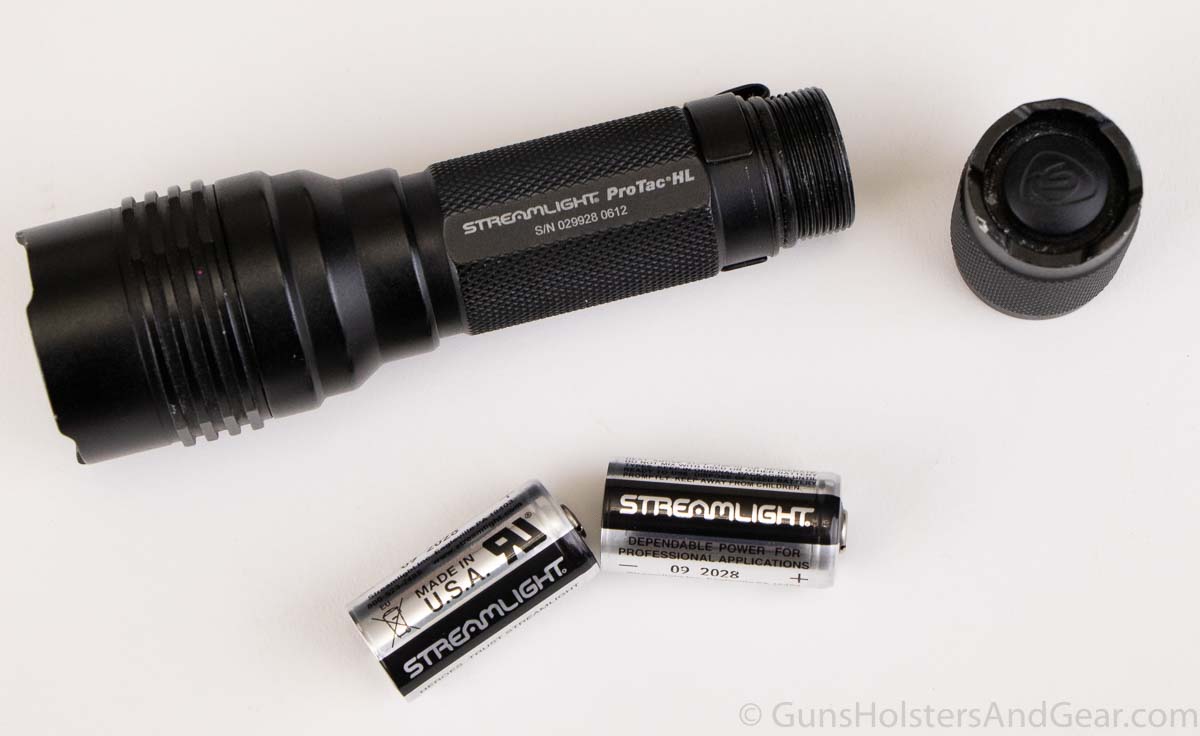
My initial ProTac HL was provided to me by Streamlight for a review on another site. Several years after that, I gave the light to my father who had taken a shine to it. Before I got home from that trip, I ordered a replacement ProTac HL from Amazon and have carried that one ever since.
Quick Takeaways
– bright and durable
– suitable for professional use, concealed carry and self-defense
– recommended
The light I gave my father served him well for light duties around his home. Since his passing, the light returned to me and now is carried daily by my wife.
This ProTac HL review is for the original version of the light rated at 600 lumens. The current version is rated at 750 lumens. Other than output, there are few differences between the original I reviewed here and the updated version.
Light Beam
One of the things I like in a handheld tactical light is a beam that casts a wide swath of light. Narrow beams are very good for reaching out to long distances, but for dealing with a problem in my driveway, clearing a room or lighting up the interior of a car as I approach it, I have found a wide beam to be preferable. Your needs may be different.
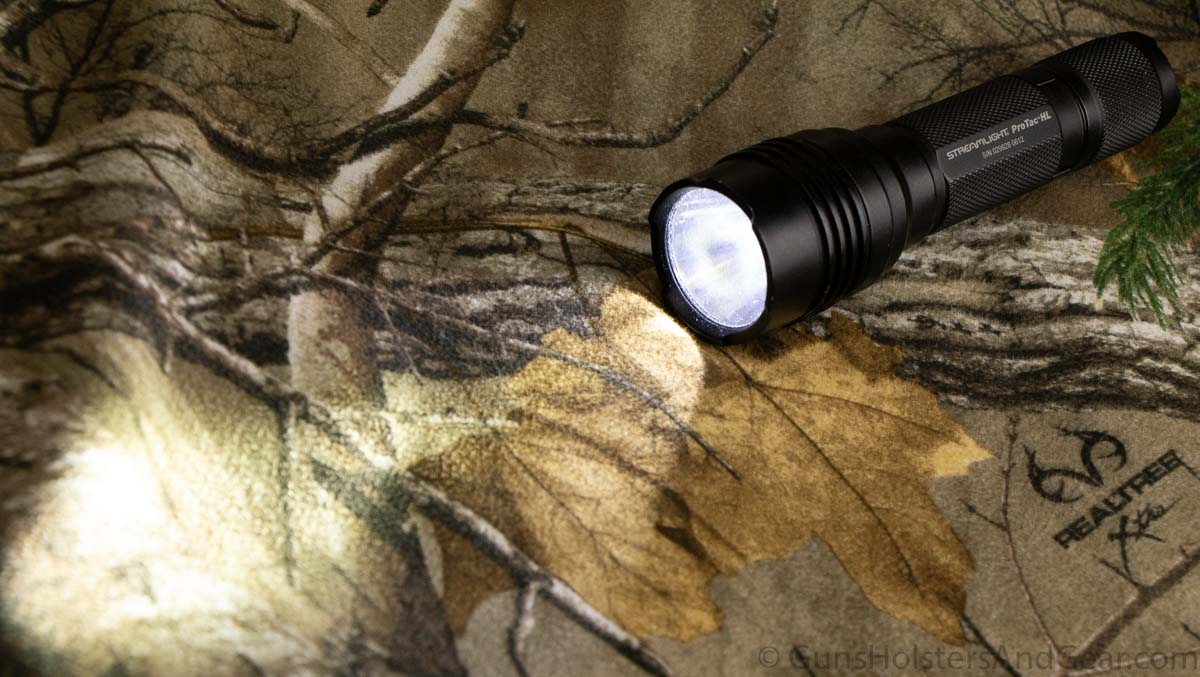
The ProTac HL is bright with a wide spill, yet it maintains a respectable reach. In practice, this means I can positively identify a threat across the back yard, but still light up a large room without having to pan it back and forth.
The center portion of the beam is definitely brighter than the edges. But it is not a hard, tight spot that you will find with the company’s HPL flashlights. This is neither good or bad, just a difference in lighting techniques you need to be aware of prior to purchase.
Controls
Like most tactical flashlights, the Streamlight ProTac HL has a tail-mounted push button switch. A half-press allows for a momentary activation of the light, while a full press and click turns the light on in a constant mode.
Streamlight uses the same single switch to control the different modes of light and to program how you access these. I found the controls easy to use. However, the description of how the switch works can sound more difficult than it is. I’ll walk you through how it works – just keep in mind that I find it much easier than it sounds.
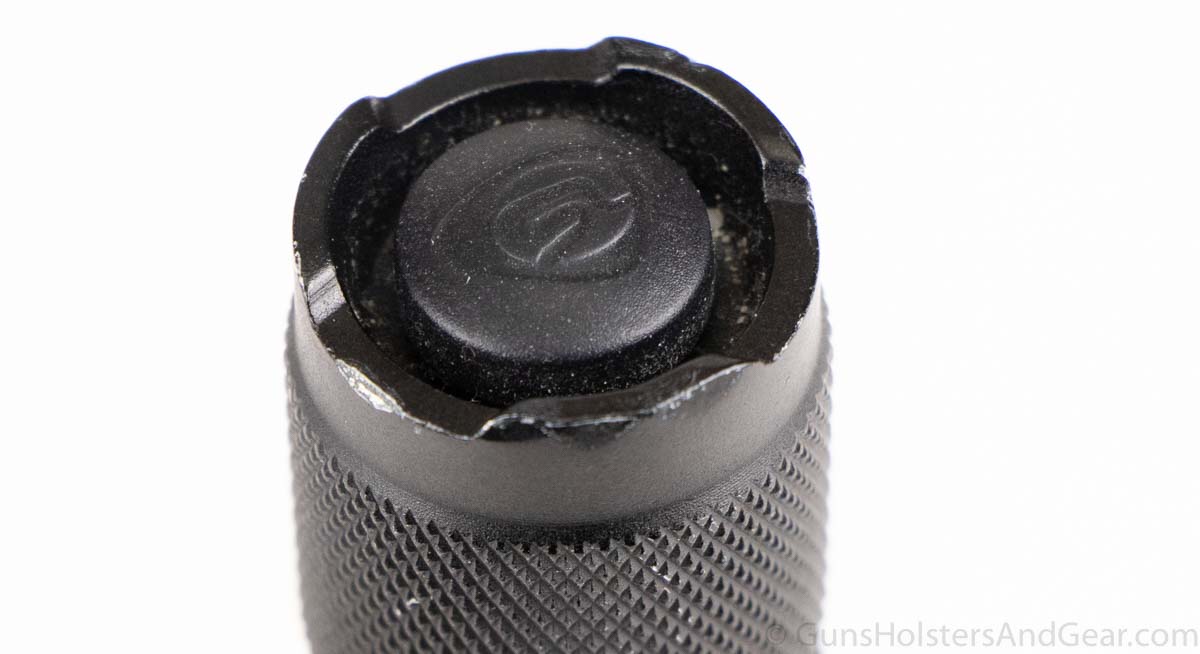
By default, the flashlight ships with the first program activated. This program allows you to access high, strobe and low output modes. A momentary press or full click puts you into the high mode.
However, you can quickly access the strobe function by rapidly half-pressing twice and holding the button either at the half-press or by fully clicking in. Once you exit the strobe mode – by releasing the half-press or by clicking the light off – the flashlight returns to the high output mode by default.
If you rapidly half-press the switch three times, it will now be in the low output mode. As with the strobe, releasing the partially depressed button, or clicking it off, will return the flashlight to the high output mode.
The default program was the most useful to me as a police officer. I could instantly access either the constant on or strobe modes, yet transition to a low output mode when doing a minor task such as reading a witness statement.
Not once did I accidentally activate the strobe or low power modes when clearing buildings using the momentary switch.
Although I found the strobe mode to be useful, I recommend it only to people who have trained with it. For most people, I suspect a high output-only program is the best choice. Fortunately, that is one of the programed options for this light. Another program allows for both a high and low output mode (no strobe).
You can change the programs easily by following the instructions provided by Streamlight:
The ProTac HL features a TEN-TAP programmable switch allowing the user to select one of three different programs.
To change to the next program, tap the switch rapidly 9 times (within 0.4 seconds per tap) and hold it down the 10th time.
Continue holding the switch until the light turns off (approximately 1 second), then release the switch.
Available programs are Hi-Strobe-Lo (Factory Default), Hi Only or Lo-Hi.
Ease of Carry
Carrying the Streamlight ProTac HL is easy. It comes with both a pocket clip and a nylon sheath for belt carry.
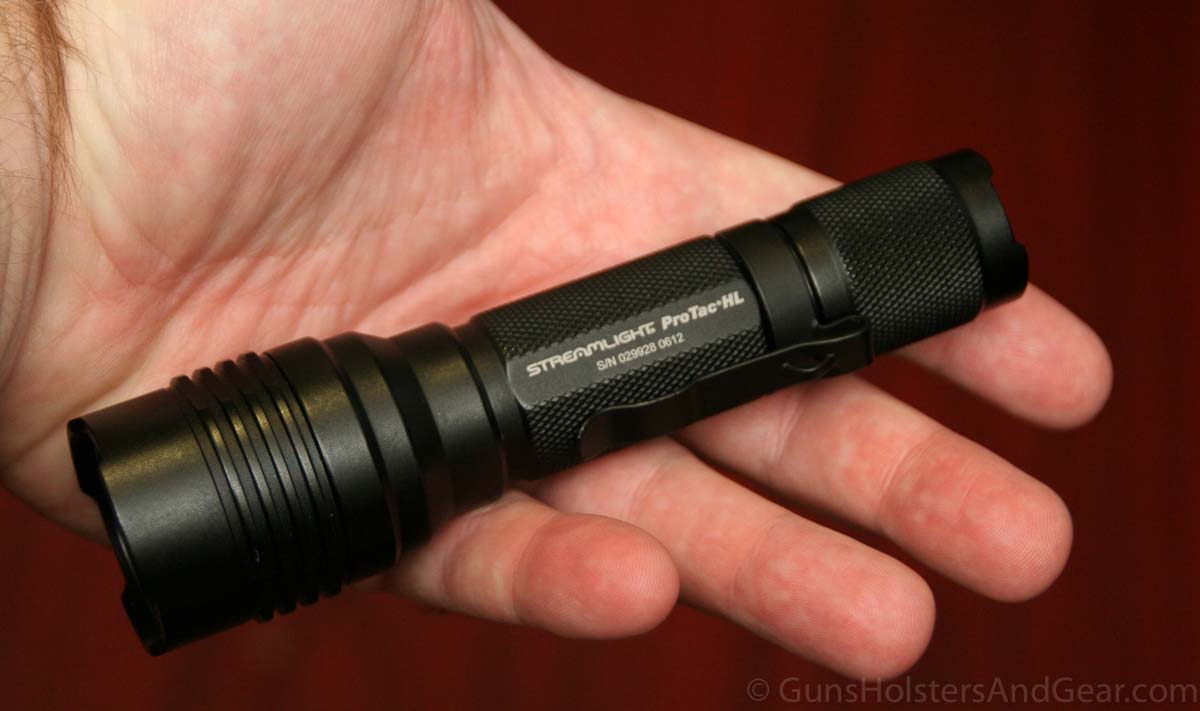
The light is large enough that it can make an uncomfortable bulge in a front pocket if carried loose. I found that when clipped to my pocket like a knife, it was no problem at all. Likewise, the light dropped into and rode easily in a cargo pocket.
The switch is protected by small ears, and I do not recall having any accidental activations with this light.
Specifications
At the time this flashlight entered production, Streamlight adhered to the testing and product labeling specifications presented in the ANSI/NEMA FL1 2009 standard. The voluntary FL1 standard is designed to provide consumers a way of comparing flashlights from different manufacturers.
I should note that the FL1 standard was updated after this product launched. The current standard is the ANSI/PLATO FL1 2016 standard. Streamlight tests its new flashlights to the current standard.
| Original HL | Updated HL | |
| Total Light Output | 600 lumens | 750 lumens |
| Peak Beam Intensity | 16,000 candelas | 18,300 candelas |
| Beam Distance | 253 meters | 270 meters |
| Power | 2x CR123A | 2x CR123A |
| Runtime | 1 hour 15 minutes | 1 hour 15 minutes |
| Weight (w/ batteries) | 5.6 oz | 5.5 oz |
| Length | 5.4″ | 5.25″ |
| Impact Resistance | 1 meter | 1 meter |
| Water Resistance | IPX7 (waterproof 1 meter for 30 minutes) | IPX7 (waterproof 1 meter for 30 minutes) |
According to a customer service representative, Streamlight uses pulse width modulation (PWM) as its standard method of dimming LED flashlights.
Testing
Independent testing of flashlights is desperately needed in the tactical, outdoor and personal protection industries. This is one of the functions that I hope I serve with GunsHolstersAndGear.com.
Through testing, I have discovered that some companies try to game the specs while others outright lie. This is a sad reality and one that the FL1 standard is supposed to help guard against. Nevertheless, the problem remains.
My testing of Streamlight flashlights has generally shown them to be reliable and suggestive that the company is adhering closely to the voluntary FL1 standard.
Past performance is not a reliable predictor of future quality, however. So, I test every all lights and report the results equally. Read more on my flashlight testing here.
Output Over Time
Streamlight rated the original ProTac HL as having 600 lumens total light output. The company rated the runtime as 1 hour 15 minutes on the high output mode. These numbers were determined through ANSI/NEMA FL1 standardized testing.
Unfortunately, the FL1 standard is flawed from the standpoint of it can be easily gamed by unscrupulous companies.
Per the standard, the output is essentially the peak output while the runtime is the amount of time that passes until the output slips to just 10% of the peak. These numbers do not tell you how long you can expect to receive a specified output.
I test for output over time. The following graph shows how much light is put out relative to its initial peak:
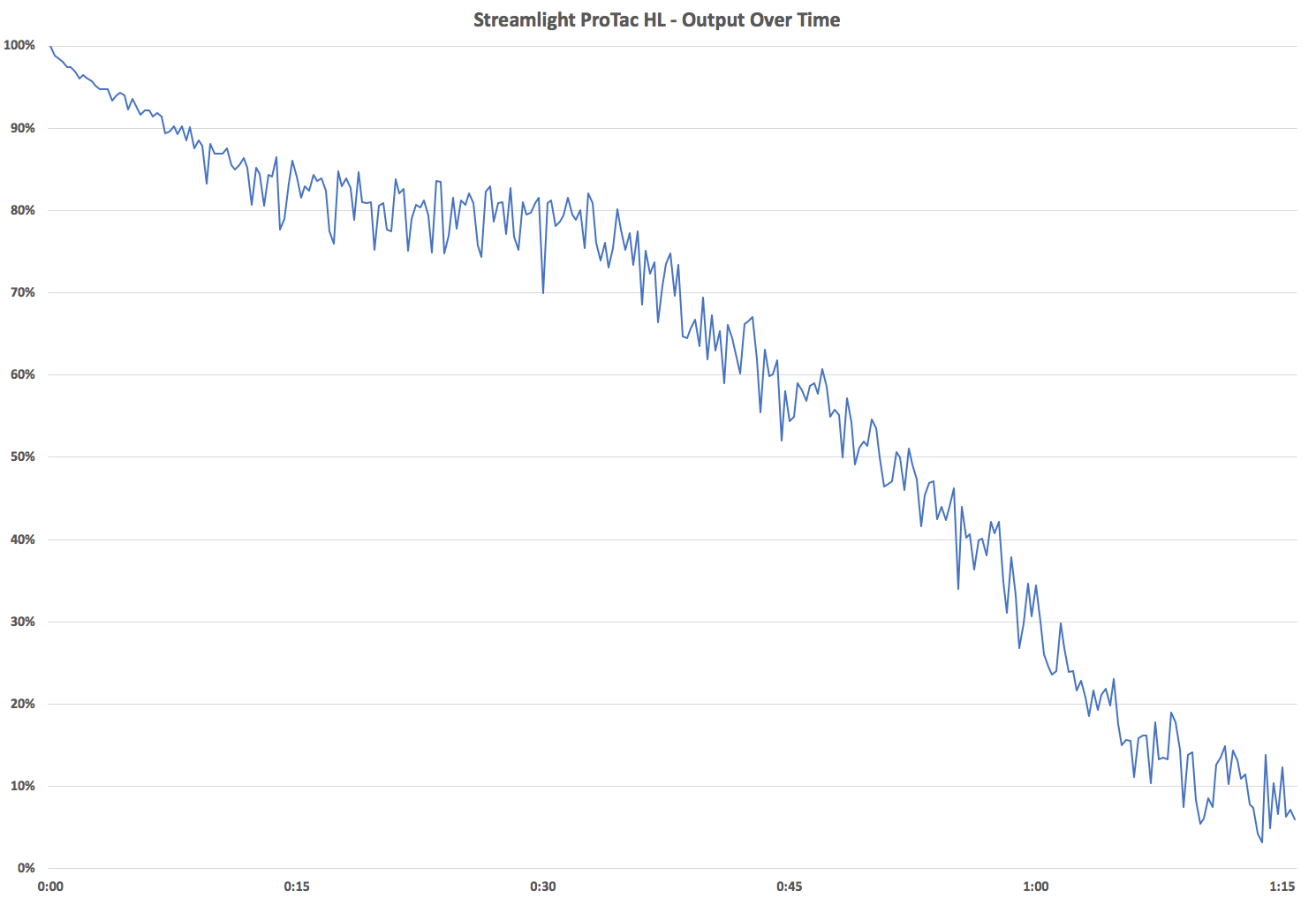
These are two subsequent runs I did:
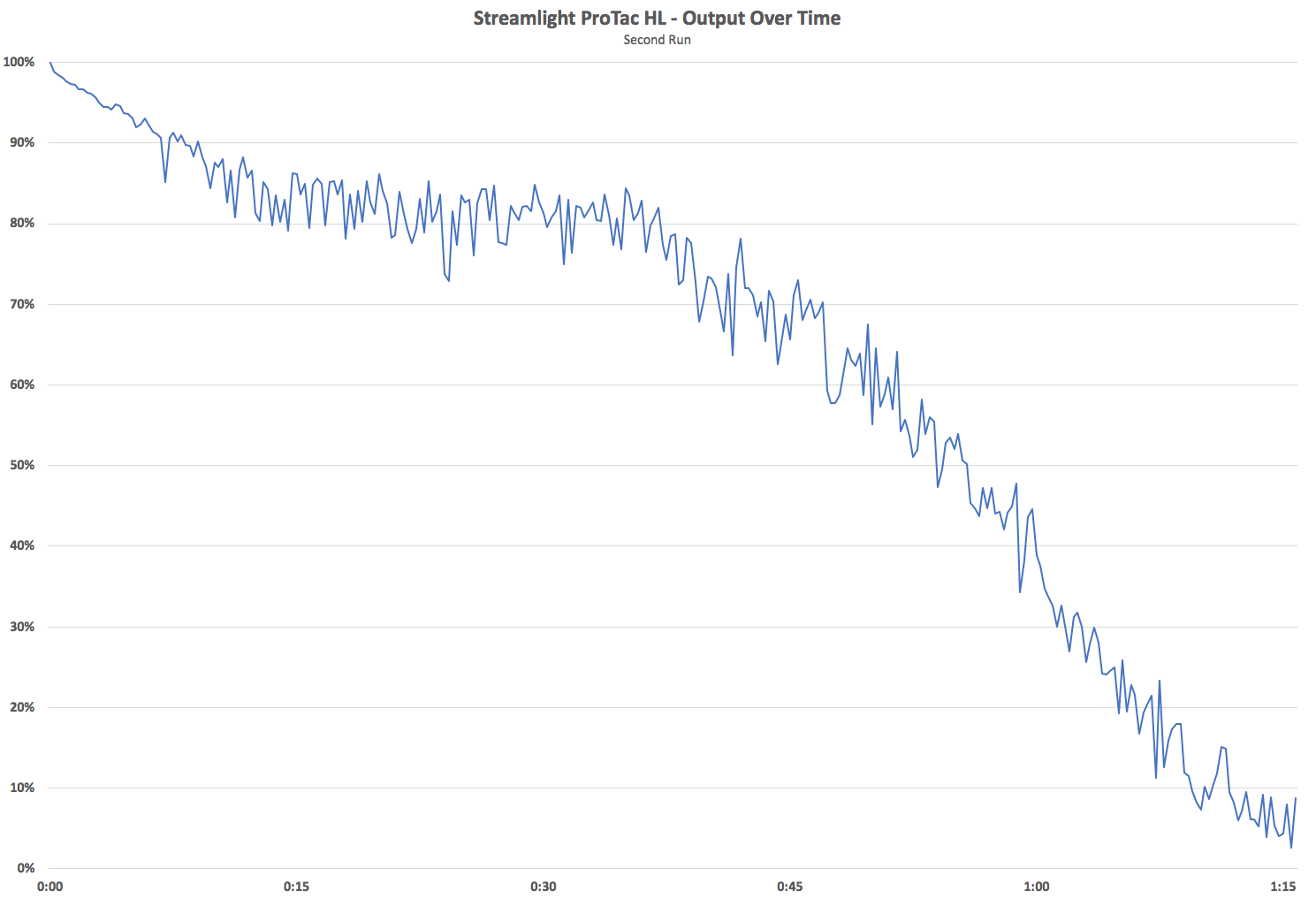
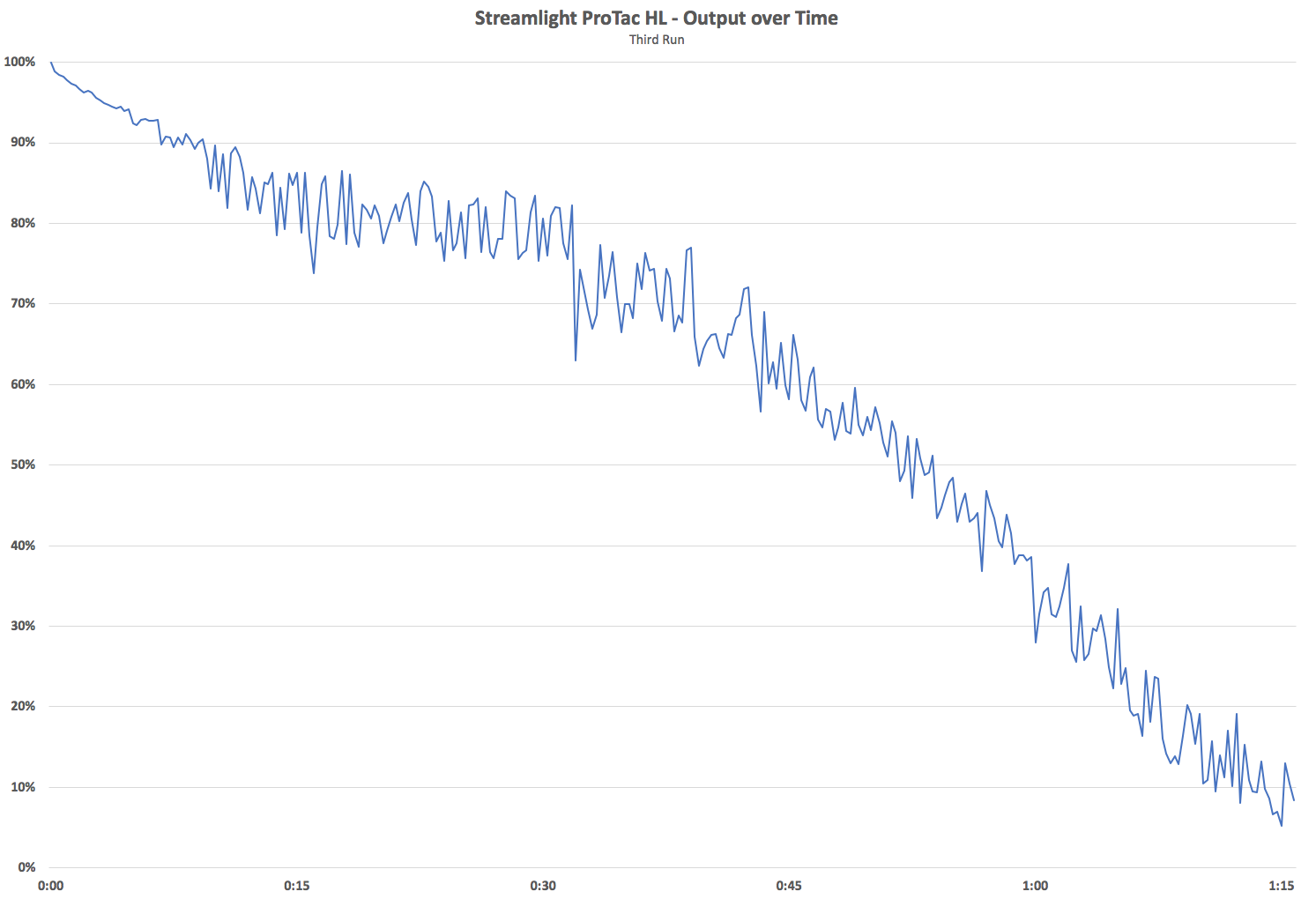
In my testing, I saw the light dip below the 10% threshold at 1 hour, 9 minutes. This is close to the rated 1 hour 15 minutes. I ran the test two additional times and saw the runtime to 10% as 1 hour, 13 minutes and 1 hour, 9 minutes respectively. These tests would seem to fall within an acceptable margin of variance that likely exists with battery and LED production.
Nevertheless, I feel that a runtime measurement to 10% is a bogus specification. Virtually no one would wait to replace the batteries in a light until the light dips below 10% of its initial output. I suspect most people will swap cells when the light output is around 50% of the initial brightness.
Runtime to 50% was respectable for the ProTac HL. The first test I ran took the flashlight 49 minutes to reach the 50% mark. Subsequent tests showed 50% runtimes of 54 and 51 minutes.
Based on my testing, I would expect to get about 50 minutes of high output use from a single set of batteries. I can (and did) happily live with that.
Heat Generation
High-powered flashlights produce a lot of heat. Efficient electronics and throttled output can reduce the amount of heat produced by a flashlight, but a manufacturer has to make choices when it comes to how expensive and how bright it wants to make the light.
The Streamlight ProTac HL is a legitimate 600 lumens flashlight and it will produce quite a bit of felt heat. This is what I measured during runtime testing on the highest output mode:
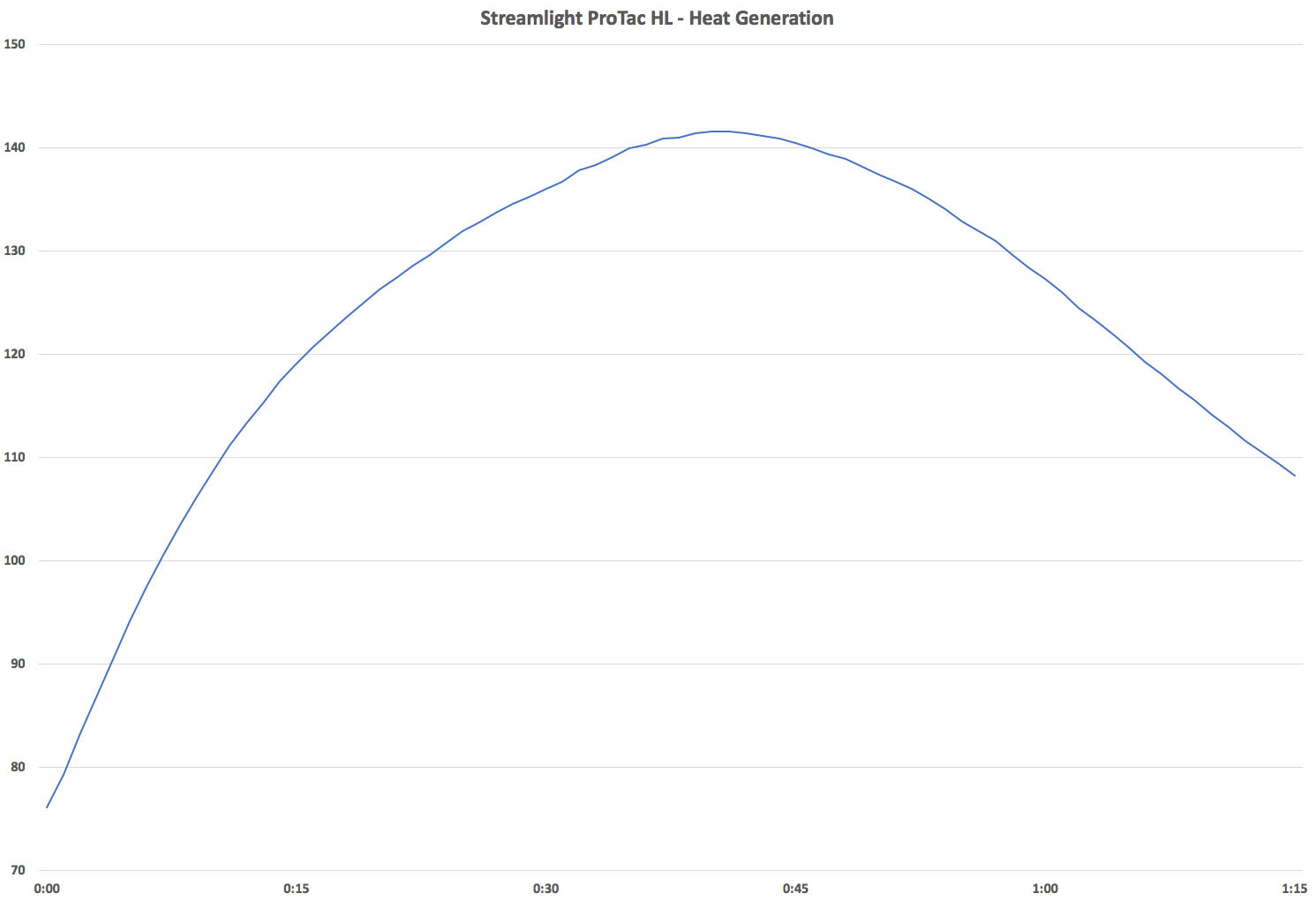
As you can see, the ProTac HL gets ridiculously hot – peaking at 141.6° F. That is far too hot for someone to hold without gloves.
However, it took the light 40 minutes to reach that peak temperature. It is unlikely you would hold the light with it running on high for that long. Rather, it is more likely you would run it on high for a few minutes at a time. At the 10 minute mark, the light is only at 108.8° F. That is hot, but you can still hold it and without burning your hand.
Visual Comparison
This light is bright, but how does that translate into useable light? Here is a series of images I took to demonstrate the capabilities of the ProTac HL on its high mode.
All of the images below were taken with a Canon 80D digital SLR camera and a 18-135mm IS USM lens. The color temperature was set to 5250° K which matches the camera’s reading of full sunlight at midday.
This image shows the shirt used in the images taken under studio LED lights rated at 5500° K. On my monitors, the colors are reproduced perfectly with the camera’s 5250° K setting. The center stripe of the shirt is white and the blues are a rich navy color. It is offered as a base comparison for the flashlight’s light in the following photos.
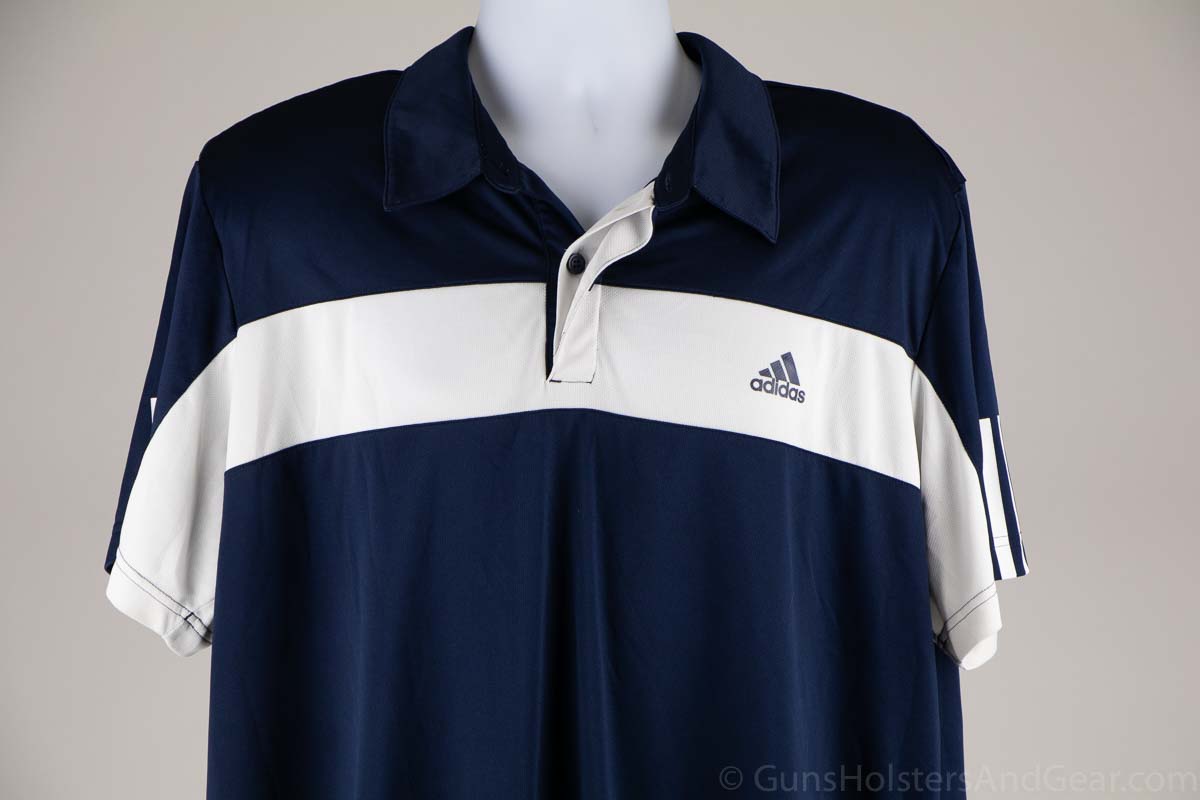
I took the following photos at a distance of 7 yards. The lens was set to 59mm with f8.0 @ 0.25 seconds and an ISO of 400. The SUV in the foreground is black with a thin cover of pollen on it. No moon was visible, but there was some street lighting nearby, just out of the photo.
Note: Click and drag the slider to see both of the photos.


The next set of photos were taken at a distance of 7 yards also. The lens was zoomed to 85mm with camera settings of f8.0 @ 2.0 seconds and an ISO of 400. In this area, there was virtually no ambient lighting and no visible moon.


Also taken at 7 yards, this set of photos was taken at 35mm, which, with the camera’s “crop factor”, provides what is known as a normal view. It captures not only the main subject, but also much of the periphery around it.
The photos were taken with the same settings as the previous photo: f8.0 @ 2.0 seconds and an ISO of 400.


For the next set of photos, I moved the distance farther back to 15 yards (45 feet). The camera settings remained the same with the lens zoomed into 85mm.
As you can see, the light is still bright though it appears less overpowering. Having been on the receiving end, it remains blinding – especially if your eyes had adjusted to the darkness.


For this final photo set, I took the photos at 15 yards with the lens zoomed at 35mm. Other camera details remain the same.
In this photo, you can see the Streamlight ProTac HL provides a great deal of spill so that a wide area can be illuminated.


Visual Comparison Update
Since I started writing this ProTac HL review, I purchased a SureFire G2X Tactical flashlight. The G2X is similar to the ProTac HL, with the same rated output: 600 lumens. I thought it would be a good idea to compare the output of the two lights.
The following images were taken at 7 yards with the same camera set up. In the first set of images, the lens was zoomed to 35mm with the settings as f8.0 @ 2.0 seconds and ISO 400.
The Streamlight photo is on the left while the SureFire is on the right.


This second set of images were taken at 15 yards with a 35 mm zoom and the same exposure settings.
The Streamlight photo is on the left while the SureFire is on the right.


In this final set of comparison images, the distance was 7 yards with a 59mm zoom. The camera settings were ISO 400 with an f8.0 at 0.25 seconds.
The Streamlight photo is on the left while the SureFire is on the right.


Taking a look at the photos, it appears the SureFire offers slightly better periphery illumination. However, the Streamlight appears to have a whiter color. The SureFire appears to have a slight green cast to it.
Drop Test
Streamlight rates the ProTac HL as being impact resistant to 1 meter. Since the flashlight was tested to the ANSI/NEMA FL1 2009 standard, this means that multiple samples of the light survived six drops (each) onto cured concrete from a height of no less than 1 meter.
My testing consists of dropping the light six times onto a concrete sidewalk. Imagine the flashlight as a cube – I drop the flashlight onto each of the six sides. This means both the head and the tail will take direct, head on impacts.
After all of the drops, the flashlight continued to work without any issues. The glass and body were all intact and did not appear to have anything more than superficial scuffs to the finish.
Speaking of the finish, Streamlight appears to use a higher quality anodizing process than many other brands. The surface marks on the ProTac HL were very minor in comparison to what I’ve seen on flashlights manufactured by other companies.
All of the photos of the flashlight on this page were taken after more than 5 years of use and the drop test.
Water Resistance
The ProTac HL is rated to the IPx7 requirement. This means the flashlight is submersible to one meter for no less than 30 minutes.
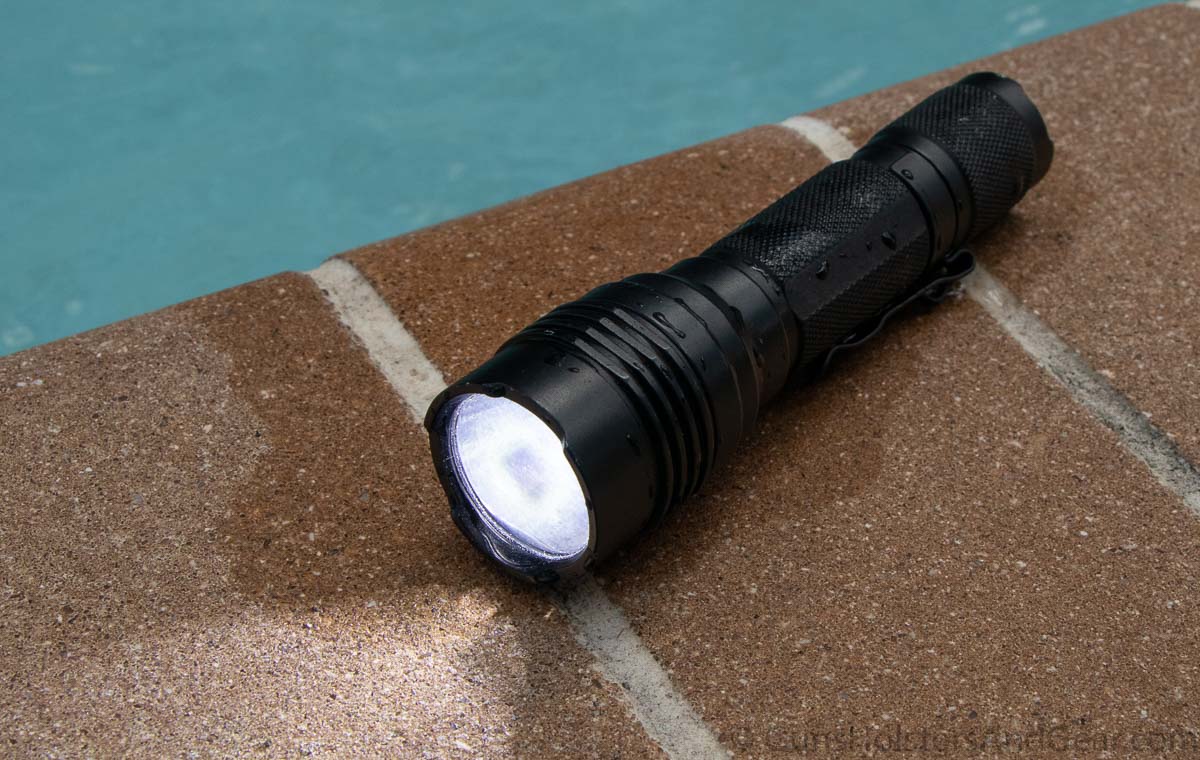
I conduct a water submersion test on any flashlight that claims an IPx7 or IPx8 rating. My test is to submerge the light for no less than 30 minutes in a pool at a depth of 1 meter. This test is always conducted after the drop test to ensure the drop test does not cause any damage that would impact the flashlight’s integrity.
In this case, the light was tested after 5.5 years of use and more drops than I can count.
The Streamlight ProTac HL passed the water test with no problems. After 30 minutes, the flashlight had no visible water intrusion and worked as it had prior to being submerged. I could not ask for anything more.
Final Thoughts
The Streamlight ProTac HL is a solid tactical flashlight suitable for personal protection and law enforcement use. Output is bright with a wide spill, and a single set of batteries should get you about 50 minutes of use.
Durability is excellent with these lights. I’ve run two in various capacities for more than five years. Both work as well today as they did when they were brand new.
While the switch program may not be ideal for everyone, it is programable meaning that you can easily change it to a format that works best for you.
I recommend the ProTac HL. I’ve used mine constantly with great performance, and I expect you will receive the same service as well. At this time, Amazon appears to have the best price on the updated version with free Prime shipping.
Last Update: August 21, 2021
Disclosures
I disclose all information that may impact how I write my flashlight reviews. Too many so-called reviews on the internet are nothing more than paid advertising. If a review does not disclose potential biases, you should ask why not.
I purchased the ProTac HL flashlight reviewed through Amazon.
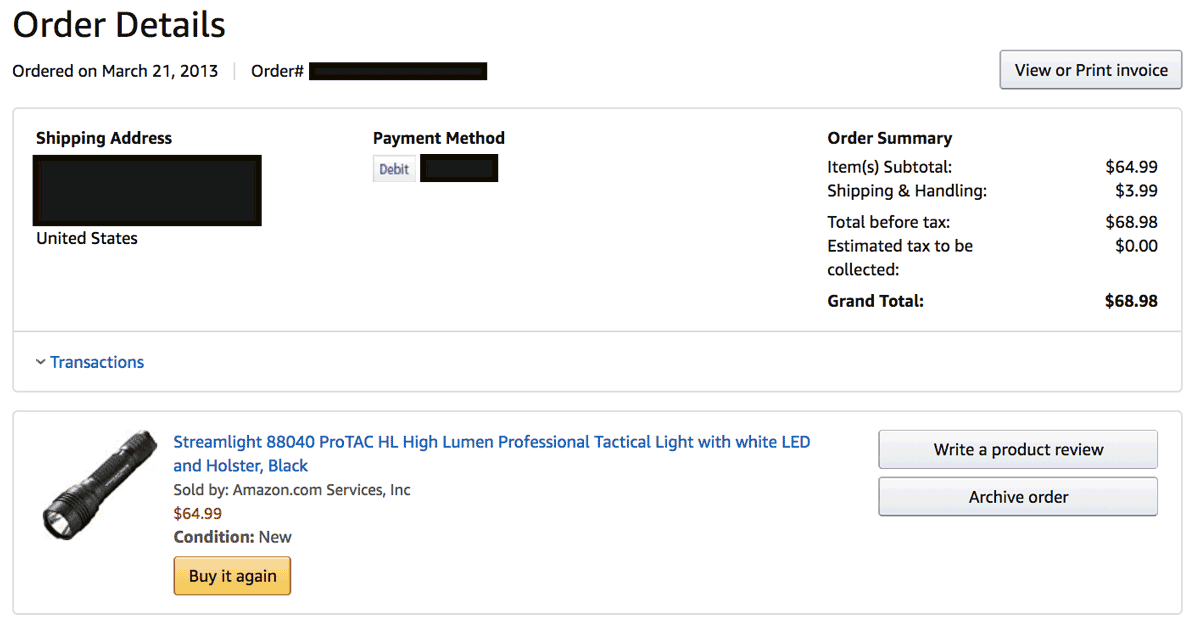
As mentioned in the article, this is the second ProTac HL that I have owned, with the first being provided to me by Streamlight for review. That flashlight was previously reviewed in another media outlet with the same general conclusion.
Streamlight is not an advertiser nor have they “sponsored” this (or any) article. I have no financial interest in Streamlight or any other flashlight manufacturer.
GunsHolstersAndGear.com is a for-profit website. I do not charge readers a dime to access the information I provide.
Some of the links on this page and site are affiliate links to companies like Amazon and Palmetto State Armory. These links take you to the products mentioned in the article. Should you decide to purchase something from one of those companies, I make a small commission.
The links do not change your purchase price. I do not get to see what any individual purchases.
If you have any questions about my disclosure, feel free to ask in the comments section below.
Also, I encourage everyone to share their experiences with tactical flashlights. It is my firm belief that we all benefit when we share the good & bad on lights we have tried. I do ask that people keep things civil and refrain from using profanity. I want GHG to be a family friendly site.
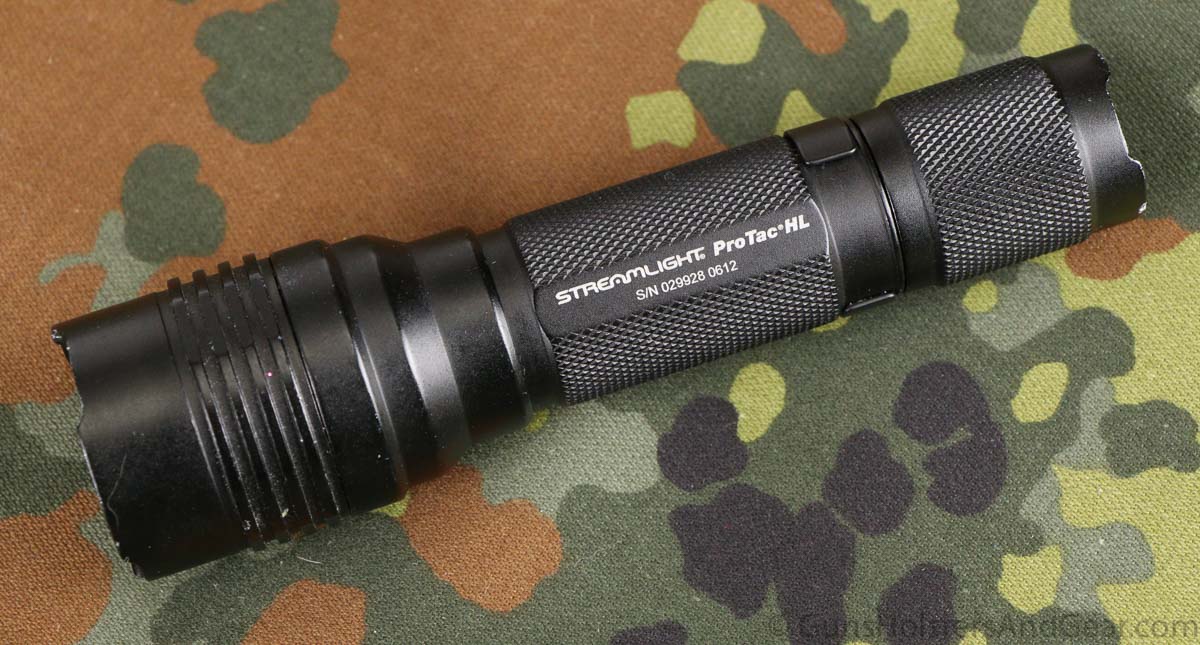
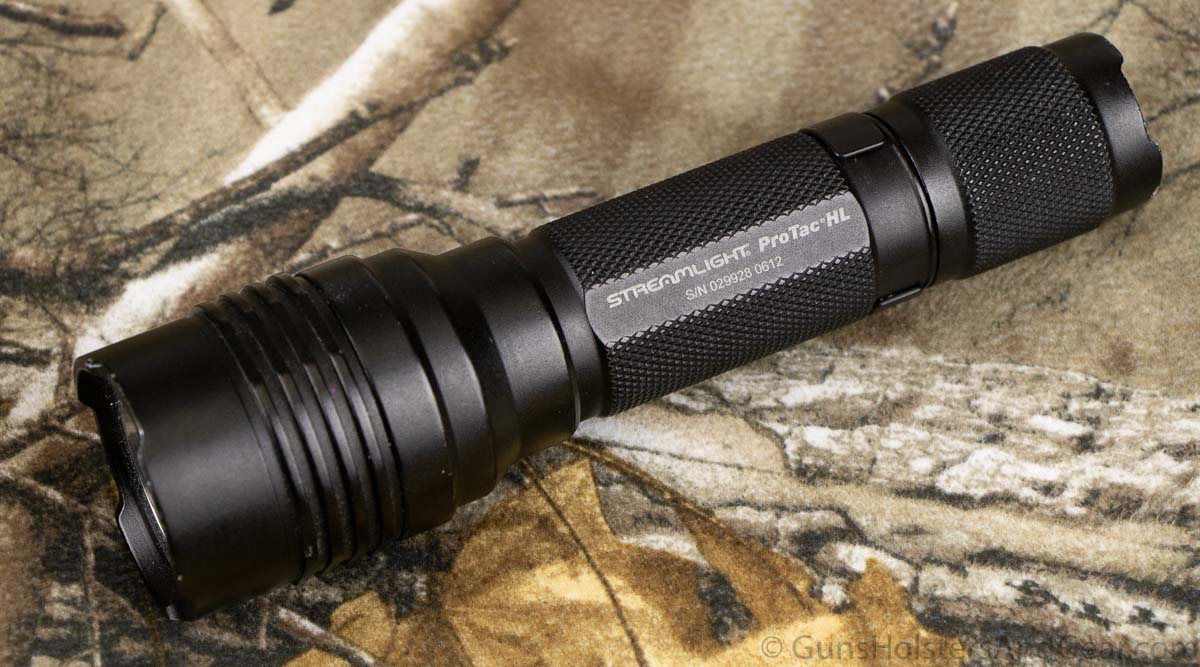
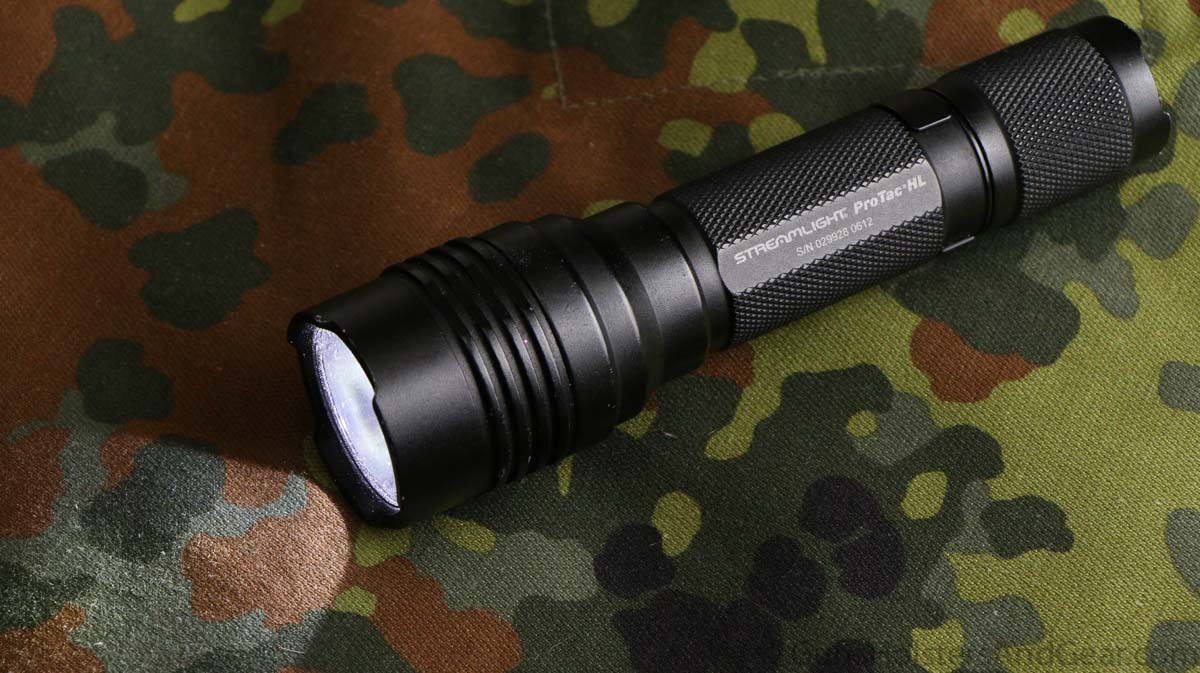
3 replies on “Streamlight ProTac HL Review – A Serious Tactical Flashlight”
I’ve got one of these lights and agree with everything said here. Mine has been super durable (I stupidly threw it at a car once – that’s a long story) and runs for a long time on one set of cells. Love the runtime graphs. I wish everyone could do those, but they dont, so thats why I always come here to read a -real- review. Thanks!!!
Hi Tran,
Thanks for taking the time to read my review and posting your thoughts. I’d love to hear the story about throwing the light at a car…
-Richard
I’m really impressed with the power and durability of the Streamlight ProTac HL. The review did a great job of highlighting its key features and I especially appreciated the discussion of its tactical applications. I’ve been looking for a reliable flashlight to carry on my hikes and this one seems like a great choice.